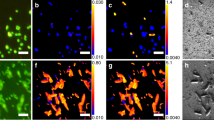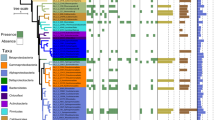Abstract
Since its discovery over two decades ago, the deep subsurface biosphere has been considered to be the realm of single-cell organisms, extending over three kilometres into the Earth’s crust and comprising a significant fraction of the global biosphere1,2,3,4. The constraints of temperature, energy, dioxygen and space seemed to preclude the possibility of more-complex, multicellular organisms from surviving at these depths. Here we report species of the phylum Nematoda that have been detected in or recovered from 0.9–3.6-kilometre-deep fracture water in the deep mines of South Africa but have not been detected in the mining water. These subsurface nematodes, including a new species, Halicephalobus mephisto, tolerate high temperature, reproduce asexually and preferentially feed upon subsurface bacteria. Carbon-14 data indicate that the fracture water in which the nematodes reside is 3,000–12,000-year-old palaeometeoric water. Our data suggest that nematodes should be found in other deep hypoxic settings where temperature permits, and that they may control the microbial population density by grazing on fracture surface biofilm patches. Our results expand the known metazoan biosphere and demonstrate that deep ecosystems are more complex than previously accepted. The discovery of multicellular life in the deep subsurface of the Earth also has important implications for the search for subsurface life on other planets in our Solar System.
This is a preview of subscription content, access via your institution
Access options
Subscribe to this journal
Receive 51 print issues and online access
$199.00 per year
only $3.90 per issue
Buy this article
- Purchase on Springer Link
- Instant access to full article PDF
Prices may be subject to local taxes which are calculated during checkout


Similar content being viewed by others
References
Pedersen, K. The deep subterranean biosphere. Earth Sci. Rev. 34, 243–260 (1993)
Onstott, T. C. et al. in Enigmatic Microorganisms and Life in Extreme Environments (ed. Seckbach, J. ) 487–500 (Kluwer, 1998)
Amend, J. P. & Teske, A. Expanding frontiers in deep subsurface microbiology. Palaeogeogr. Palaeoclimatol. Palaeoecol. 219, 131–155 (2005)
Whitman, W. B., Coleman, D. C. & Wiebe, W. J. Prokaryotes: the unseen majority. Proc. Natl Acad. Sci. USA 95, 6578–6583 (1998)
Sinclair, J. L. & Ghiorse, W. C. Distribution of aerobic bacteria, protozoa, algae and fungi in deep subsurface sediments. Geomicrobiol. J. 7, 15–31 (1989)
Ekendahl, S., O’Neill, A., Thomsson, E. & Pedersen, K. Characterisation of yeasts isolated from deep igneous rock aquifers of the Fennoscandian shield. Microb. Ecol. 46, 416–428 (2003)
Heip, C., Vincx, M. & Vranken, G. The ecology of marine nematodes. Oceanogr. Mar. Biol. 23, 399–489 (1985)
Lambshead, P. in Nematode Morphology, Physiology and Ecology Vol. 1 (eds Chen, Z. X., Chen, S. Y. & Dickson, D. W. ) 438–492 (Tsinghua Univ. Press, 2004)
Föll, R. L. et al. Anaerobiosis in the nematode Caenorhabditis elegans . Comp. Biochem. Physiol. 124B, 269–280 (1999)
Moser, D. P. et al. Desulfotomaculum spp. and Methanobacterium spp. dominate 4–5 km deep fault. Appl. Environ. Microbiol. 71, 8773–8783 (2005)
Dorris, M., De Ley, P. & Blaxter, M. Molecular analysis of nematode diversity and the evolution of parasitism. Parasitol. Today 15, 188–193 (1999)
Holterman, M. et al. Phylum-wide analysis of SSU rDNA reveals deep phylogenetic relationships among nematodes and accelerated evolution toward crown clades. Mol. Biol. Evol. 23, 1792–1800 (2006)
Lippmann, J. et al. Dating ultra-deep mine waters with noble gases and 36Cl, Witwatersrand Basin, South Africa. Geochim. Cosmochim. Acta 67, 4597–4619 (2003)
Onstott, T. C. et al. The origin and age of biogeochemical trends in deep fracture water of the Witwatersrand Basin, South Africa. Geomicrobiol. J. 23, 369–414 (2006)
Gihring, T. M. et al. The distribution of microbial taxa in the subsurface water of the Kalahari Shield, South Africa. Geomicrobiol. J. 23, 415–430 (2006)
Michel, R. L. in Isotopes in the Water Cycle: Past, Present and Future of a Developing Science (eds Aggarwal, P. K., Gat, J. R. & F roelich, K. F. O. ) Ch. 5, 53–66 (Springer, 2005)
Wanger, G., Onstott, T. C. & Southam, G. Structural and chemical characterization of a natural fracture surface from 2.8 kilometers below land surface: biofilms in the deep subsurface. Geomicrobiol. J. 23, 443–452 (2006)
Ferris, H., Venette, R. C. & Lau, S. S. Population energetics of bacterial-feeding nematodes: carbon and nitrogen budgets. Soil Biol. Biochem. 29, 1183–1194 (1997)
van Voorhies, W. & Ward, S. Broad oxygen tolerance in the nematode Caenorhabditis elegans . J. Exp. Biol. 203, 2467–2478 (2000)
Van Voorhies, W. A. & Ward, S. Genetic and environmental conditions that increase longevity in Caenorhabditis elegans decrease metabolic rate. Proc. Natl Acad. Sci. USA 96, 11399–11403 (1999)
Phelps, T. J., Murphy, E. M., Pfiffner, S. M. & White, D. C. Comparison between geochemical and biological estimates of subsurface microbial activities. Microb. Ecol. 28, 335–349 (1994)
Ocana, A. Relationship between nematode species and the physico-chemical characteristics of spring waters. II. Temperature. Nematol. Mediterr. 19, 25–28 (1991)
Neher, D. A. & Powers, T. O. in Encyclopedia of Soils in the Environment Vol. 3 (eds Hillel, D. et al.) 1–5 (Academic, 2004)
Hoeppli, R. & Chu, H. J. Free-living nematodes from hot springs in China and Formosa. Hong Kong Nat. 1 (suppl.). 15–29 (1932)
Jana, B. B. The thermal springs of Bakreswar, India: physico-chemical conditions, flora and fauna. Hydrobiologia 41, 291–307 (1973)
Engel, A. S. Observations on the biodiversity of sulfidic karst habitats. J. Cave Karst Stud. 69, 187–206 (2007)
Edwards, K. J., Bach, W. & McCollom, T. M. Geomicrobiology in oceanography: microbe–mineral interactions at and below the seafloor. Trends Microbiol. 13, 449–456 (2005)
Danovaro, R. et al. The first metazoa living in permanently anoxic conditions. BMC Biol. 8, 30–40 (2010)
Yeates, G. W., Bongers, T., Goede, R. G. M., d, Freckman, D. W. & Georgieva, S. S. Feeding habits in nematode families and genera — an outline for soil ecologists. J. Nematol. 25, 315–331 (1993)
Acknowledgements
G.B. is grateful to the University of Ghent for allowing a year-long sabbatical, and for grants from the FWO, BOF and UFS. We express our recognition of the support provided by Tau Tona gold mine (AngloGold Ashanti Limited), Driefontein gold mine (Gold Fields Limited), Beatrix gold mine (Gold Fields Limited), Zondereinde mine (Northern Platinum Ltd) and Star Diamonds mine (Petra Diamonds), and by the many people without whom this work would have been impossible. In particular, we are grateful to F. Rheeder, H. Möller, T. Lineque, A. Thwala, K. Sokhela, C. Rose, R. Fynn, B. Visser, O. Holovachev, T. Moens, M. Couvreur and A. Vierstraete. We are grateful to E. Botes and K. Albertyn of the University of the Free State for their contributions to the data analysis. T.C.O. acknowledges support from a National Science Foundation Continental Dynamics Program grant (EAR 0409605). E.v.H. acknowledges support from a BioPAD/UFS Metagenomics Platform grant.
Author information
Authors and Affiliations
Contributions
A.G.-M., D.L. and W.B. all contributed equally to this study. G.B., A.G.-M., D.L., A.B. and M.E. collected the filtered samples and the control samples and performed field analyses. G.B. carried out the enrichments. A.G.-M. performed microbial DNA extraction and 16S rRNA amplification, sequencing and tree construction. C.M. performed DNA analyses on filters of mining water. W.B. provided the nematode identification, their morphological description and their molecular analyses. T.C.O. modelled the geochemical, 3H and 14C data. G.B. wrote the paper with input from W.B., A.G.-M., T.C.O. and E.v.H.
Corresponding authors
Ethics declarations
Competing interests
The authors declare no competing financial interests.
Supplementary information
Supplementary Figures
This file contains Supplementary Figures 1-9 with legends. (PDF 1927 kb)
Supplementary Information
This file contains Supplementary Tables 1-5, Supplementary Methods, a Supplementary Discussion and additional references. (PDF 895 kb)
PowerPoint slides
Rights and permissions
About this article
Cite this article
Borgonie, G., García-Moyano, A., Litthauer, D. et al. Nematoda from the terrestrial deep subsurface of South Africa. Nature 474, 79–82 (2011). https://doi.org/10.1038/nature09974
Received:
Accepted:
Published:
Issue Date:
DOI: https://doi.org/10.1038/nature09974
This article is cited by
-
86Kr excess and other noble gases identify a billion-year-old radiogenically-enriched groundwater system
Nature Communications (2022)
-
Fossilized anaerobic and possibly methanogenesis-fueling fungi identified deep within the Siljan impact structure, Sweden
Communications Earth & Environment (2021)
-
Habitat differences filter functional diversity of low dispersive microscopic animals (Acari, Halacaridae)
Hydrobiologia (2021)
-
The genome of a subterrestrial nematode reveals adaptations to heat
Nature Communications (2019)
-
New ecosystems in the deep subsurface follow the flow of water driven by geological activity
Scientific Reports (2019)
Comments
By submitting a comment you agree to abide by our Terms and Community Guidelines. If you find something abusive or that does not comply with our terms or guidelines please flag it as inappropriate.



